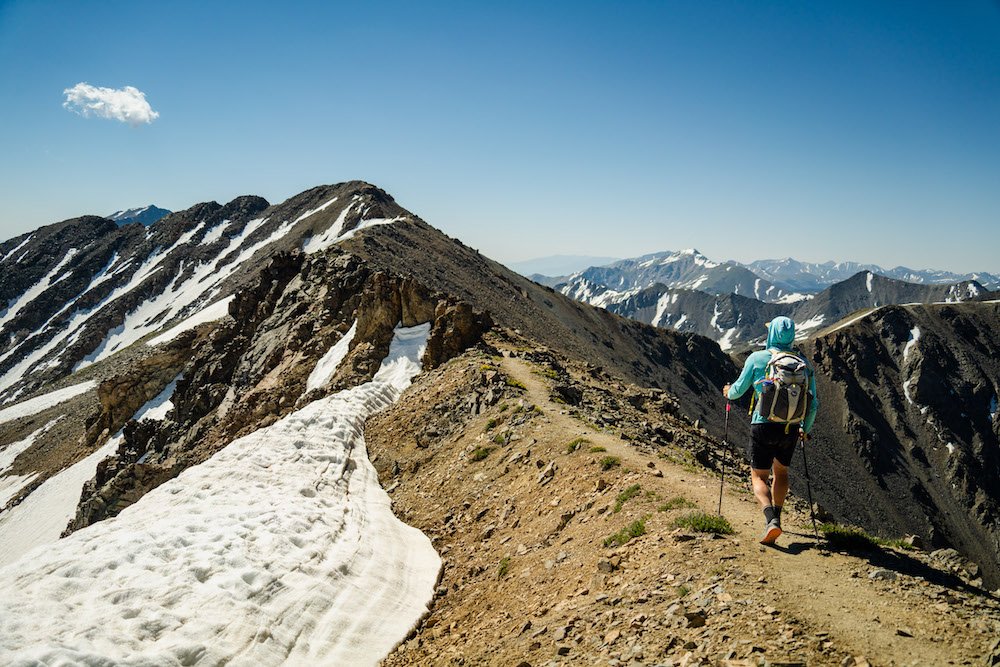The Adventure of Peak Bagging
Peak bagging is not just a hobby; it's a passion, a challenge, and a pursuit that drives adventurers to conquer some of the tallest and most majestic mountains in the world. At its core, peak bagging involves climbing mountains, particularly focusing on 14ers in the United States, which are peaks that reach an elevation of 14,000 feet or higher. This activity is popular among mountaineers and outdoor enthusiasts who seek the thrill of reaching a summit and the satisfaction of ticking off another peak from their list.
Tagging summits for sunrise. Photo by Dalton Johnson
Pros
Physical Fitness: Peak bagging is a fantastic way to stay physically fit and active. Climbing mountains requires strength, endurance, and cardiovascular fitness, contributing to overall health and well-being.
Adventure and Exploration: It provides a sense of adventure and exploration as climbers discover new trails, stunning vistas, and diverse ecosystems while ascending mountains.
Personal Growth: Conquering challenging peaks fosters personal growth, resilience, and a sense of accomplishment. It pushes individuals beyond their comfort zones and helps build confidence and determination.
Connection with Nature: Peak bagging allows climbers to immerse themselves in nature, appreciate its beauty, and develop a deeper connection with the natural world.
Community and Camaraderie: Climbers often form bonds and share experiences with like-minded individuals, creating a supportive community and fostering friendships based on shared passions.
Cons
Physical Demands: Climbing mountains can be physically demanding and strenuous, requiring adequate fitness levels and preparation. It may pose challenges for individuals with certain health conditions or fitness limitations.
Weather and Safety: Mountain weather can be unpredictable, with conditions changing rapidly. This can increase the risk of exposure to extreme temperatures, storms, and other hazards, necessitating careful planning and preparedness.
Time and Commitment: Peak bagging requires time and commitment, especially for climbing multiple peaks or tackling challenging routes. It may not be feasible for individuals with busy schedules or limited availability.
Costs: The cost of peak bagging can add up, including expenses for gear, permits (where required), travel, accommodations, and potentially guided trips or training courses. It's essential to budget accordingly.
Environmental Impact: Intensive use of popular trails and mountains can lead to environmental degradation, such as trail erosion, littering, and habitat disturbance. Climbers must practice Leave No Trace principles and minimize their impact on fragile ecosystems.
One of the most renowned regions for peak bagging is Colorado, home to a vast array of 14ers that attract climbers from all over the globe. These peaks offer a diverse range of challenges, from gentle slopes to rugged terrain, requiring varying levels of skill and experience. Some of the iconic 14ers in Colorado include Longs Peak, Mount Elbert, and Pikes Peak, each offering its own unique set of obstacles and rewards.
California is another hotspot for peak bagging, boasting iconic peaks such as Mount Whitney, the highest summit in the contiguous United States, and Mount Shasta, a majestic volcano that attracts climbers seeking both challenge and breathtaking views. Washington state also offers a plethora of 14ers, including Mount Rainier, an iconic glaciated peak that tests climbers with its steep slopes and unpredictable weather.
The allure of peak bagging lies not only in the physical challenge of scaling mountains but also in the sense of accomplishment and connection with nature that it brings. Climbers often describe the experience of standing on a summit, surrounded by vast wilderness and panoramic views, as nothing short of awe-inspiring. It's a moment of triumph, resilience, and appreciation for the natural world.
However, peak bagging is not without its risks and considerations. Mountaineers must be well-prepared and equipped with the necessary gear, including proper clothing, navigation tools, and emergency supplies. Weather conditions can change rapidly in mountainous regions, posing additional challenges and requiring climbers to exercise caution and good judgment.
Despite the challenges, peak bagging offers a myriad of rewards for those who embark on this adventure. It fosters a sense of camaraderie among climbers, as they share stories, tips, and encouragement along the way. It also encourages physical fitness, mental resilience, and a deep connection with the outdoors.
For many, peak bagging is not just about conquering mountains but also about embracing the journey, learning from each ascent, and cultivating a deeper appreciation for the natural world. It's a pursuit that fuels the spirit of exploration, adventure, and discovery, drawing individuals to seek out new summits and reach new heights both physically and metaphorically.
Summiting 14ers in the Eastern Sierra of Calirfornia. Photo by Dalton Johnson
peak bagging is more than just climbing mountains; it's a lifestyle, a passion, and a pursuit of personal growth and exploration. Whether in Colorado, California, Washington, or beyond, the allure of reaching new summits and pushing personal limits continues to inspire adventurers to embark on this exhilarating journey of peak bagging.












